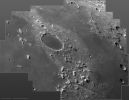|
|

Moon Eclypse~0.jpgThe "Pumpkin" Moon133 visiteUn altro eccellente lavoro dell'astronomo Sebastien Gauthier il quale, "giocando" con la "Luna arancione" dell'ultima eclisse (Ottobre 2004), si è inventato un grazioso fotomontaggio che fa assomigliare il nostro Satellite alla maschera simbolo della festa di Halloween: la zucca (pumpkin). Una bella immagine ed una prova ulteriore che la Scienza può anche essere inventiva e divertimento (basta avere un pò di passione ed un pizzico di mezzi e di attitudine).
|
|

Moon Panorama - 0.jpgMoon Panorama (1)88 visitenessun commento
|
|

Moon Panorama - 1.jpgMoon Panorama (2)84 visitenessun commento
|
|

Moon Panorama - 2.jpgMoon Panorama (3)64 visitenessun commento
|
|

Moon Panorama - 3.jpgMoon Panorama (4)78 visitenessun commento
|
|

Moon Panorama - 4.jpgMoon Panorama (5)68 visitenessun commento
|
|

Moon from Clementine.jpgThe Moon and Venus from Clementine176 visiteLa Luna e Venere visti dalla Sonda Clementine: si tratta di una splendida immagine che si commenta da sola, anche perchè, come ormai sapete, le immagini Clementine che si trovano sulla Rete non sono proprio tante. A quanto ne sappiamo, oltre alle immagini Clementine relative ad una possibile 'Lunar Flare' (più avanti, in questa Sezione), c'è anche qualche altra immagine intrigante della Luna e di alcuni dei suoi sub-satelliti (cioè i satelliti di un satellite) dei quali si sa veramente poco.
Ne parleremo, forse, quando riusciremo a trovare queste immagini...
|
|

Moon-SouthernSide.jpgThe Southern Highlands of the Moon (Moretus and Curtius)65 visiteCaption NASA:"The Moon's South Pole is near the top of this sharp telescopic view looking across the Southern Lunar Highlands. Recorded on August 3rd, 2007, from Tecumseh, Oklahoma, planet Earth, the foreshortened perspective heightens the impression of a dense field of craters and makes the craters themselves appear more oval shaped. The prominent crater in the foreground, Moretus, has a diameter of 114 Km and lies just west (left) of the Moon's Central Meridian. For large lunar craters, Moretus is young and features terraced inner walls and a 2,1 Km high, bright central peak, similar in appearance to the more northerly crater Tycho. Just to the right of Moretus is the 95 Km diameter crater Curtius.
Curtius has older, rounded walls marked by smaller, more recent impact craters".MareKromium
|
|

New_Lunar_Crater.jpgManmade new Lunar Impact Crater: Luna 25169 visitenessun commentoMareKromium
|
|

North Pole.jpgNorth Polar Region79 visitenessun commento
|
|

PlatoCrater-00.jpgPlato Crater (1)88 visiteThe dark-floored, 95 Km wide crater Plato (top) and Sunlit Peaks of the Lunar Alps are highlighted in this sharp digital mosaic of the Moon's surface. While the Alps of planet Earth were uplifted over millions of years as continental plates slowly collided, the Lunar Alps were likely formed by a sudden collision that created the giant impact basin known as the Mare Imbrium (Sea of Rains). The mare's generally smooth, lava-flooded floor is seen extending to the left. The prominent straight feature cutting through the mountain range (lower right) is the lunar Alpine Valley, about 160 Km long and up to 10 Km wide. Of course, the large, bright alpine mountain near bottom center is named Mont Blanc and reaches over 3 Km above the Lunar Surface.
|
|

PlatoCrater-06.jpgPlato Crater (2)70 visitenessun commento
|
|
| 165 immagini su 14 pagina(e) |
 |
 |
 |
 |
6 |  |
 |
 |
 |
 |
|

